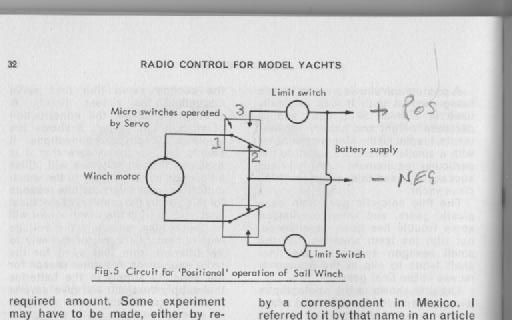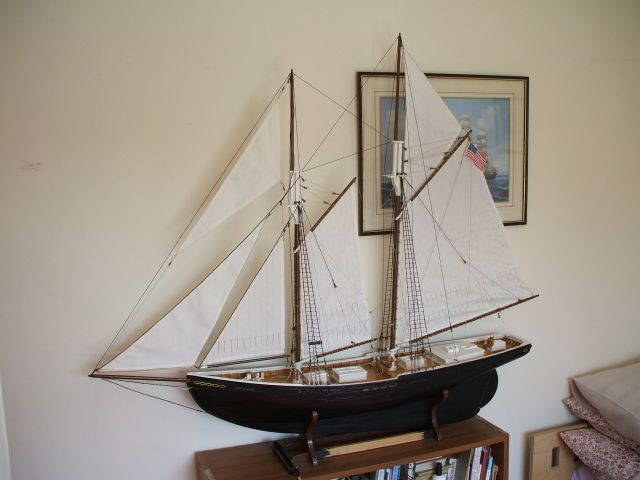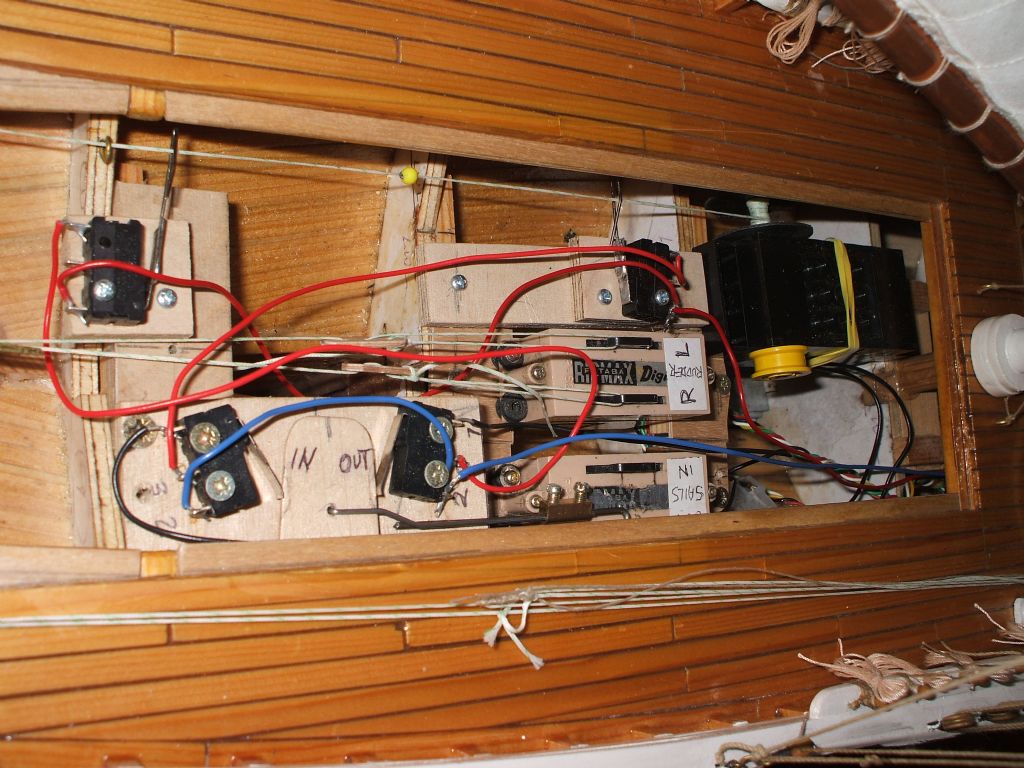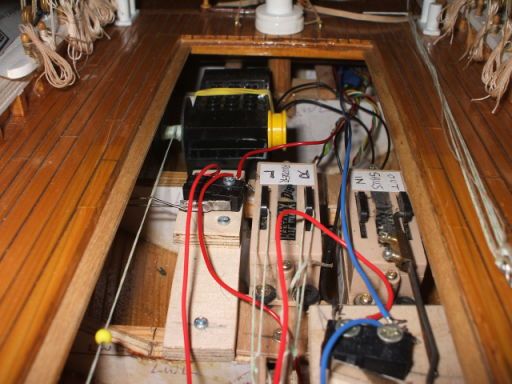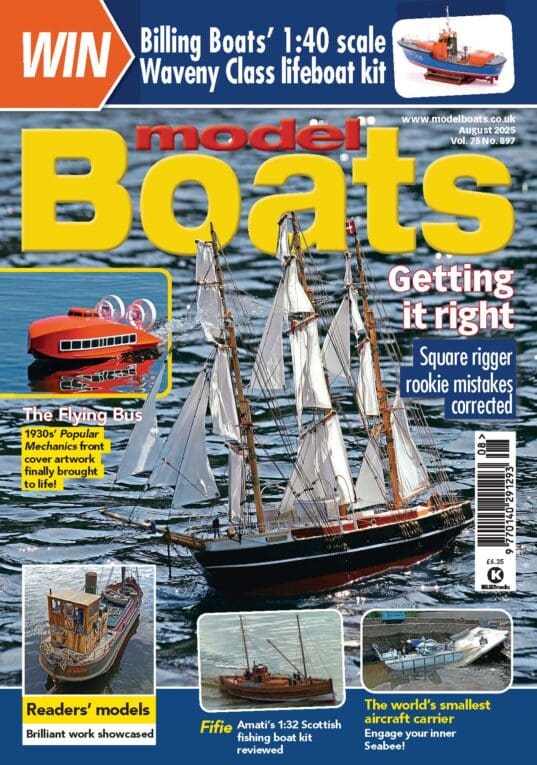I’m new to R/C, the variables seem endless. As an engineer/designer I can start at both ends of the problem.
GRP Sail boat type unknown.
1.12m lg, 25.5cm beam, Mast 1.5m, No Motor. Sails controlled separately.
Main – 6040cmsq, boom lg 41cm, attachment points at 16 or 26.5cm from gooseneck due to deck layout
Jib – 4630cmsq, boom 37cm, attachment point variable.
I bough a Hitec HS-785HB drum winch as it looks competively priced for the Torque £25/13kg.cm
Batteries choice factors – weight, size, voltage, capacity, current drain capability.
The Lead gel cell is not suitable as its mass will have to be above the waterline so reducing stability otherwise size/weight is not a problem
LiPo type appear to be for light weight, high current applications and are expensive.
This leaves NiCd and NiMh
The one piece of data I would have expected to be readily available is the max current drain of both batteries and servos.
My best estimate for the current drain is 4 to 6A
2 Hitec sail winches (1.8A stalled) + rudder (Futaba S3003 Amp?) + receiver (32mA)
Battery voltage for the servos can be either 4.8 or 6v, It seems silly not to go for 6V as the available torque is 13.3 as against 11kg.cm = 21% increase.
Should I use NiCd or NiMh?
What Ahr should I use?
I notice that some servos have a power feed from the battery, on/off switch and connector to the receiver. (The Hitec HS-785Hb does not). How does this system work?
Tony
<!–[if gte mso 9]><xml> <w:WordDocument> <w:View>Normal</w:View> <w:Zoom>0</w:Zoom> <w:Compatibility> <w:BreakWrappedTables/> <w napToGridInCell/> <w:WrapTextWithPunct/> <w:UseAsianBreakRules/> </w:Compatibility> <w:BrowserLevel>MicrosoftInternetExplorer4</w:BrowserLevel> </w:WordDocument> </xml><![endif]–><!–[if !mso]><div classid=”clsid:38481807-CA0E-42D2-BF39-B33AF135CC4D” id=ieooui> <style> st1
napToGridInCell/> <w:WrapTextWithPunct/> <w:UseAsianBreakRules/> </w:Compatibility> <w:BrowserLevel>MicrosoftInternetExplorer4</w:BrowserLevel> </w:WordDocument> </xml><![endif]–><!–[if !mso]><div classid=”clsid:38481807-CA0E-42D2-BF39-B33AF135CC4D” id=ieooui> <style> st1 {behavior:url(#ieooui) } </style> <![endif]–> <!– /* Style Definitions */ p.MsoNormal, li.MsoNormal, div.MsoNormal {mso-style-parent:””; margin:0cm; margin-bottom:.0001pt; mso-pagination:widow-orphan; font-size:12.0pt; font-family:Arial; mso-fareast-font-family:”Times New Roman”; mso-bidi-font-family:”Times New Roman”;} @page Section1 {size:612.0pt 792.0pt; margin:72.0pt 90.0pt 72.0pt 90.0pt; mso-header-margin:36.0pt; mso-footer-margin:36.0pt; mso-paper-source:0;} div.Section1 {page
{behavior:url(#ieooui) } </style> <![endif]–> <!– /* Style Definitions */ p.MsoNormal, li.MsoNormal, div.MsoNormal {mso-style-parent:””; margin:0cm; margin-bottom:.0001pt; mso-pagination:widow-orphan; font-size:12.0pt; font-family:Arial; mso-fareast-font-family:”Times New Roman”; mso-bidi-font-family:”Times New Roman”;} @page Section1 {size:612.0pt 792.0pt; margin:72.0pt 90.0pt 72.0pt 90.0pt; mso-header-margin:36.0pt; mso-footer-margin:36.0pt; mso-paper-source:0;} div.Section1 {page ection1;} –> <!–[if gte mso 10]> <style> /* Style Definitions */ table.MsoNormalTable {mso-style-name:”Table Normal”; mso-tstyle-rowband-size:0; mso-tstyle-colband-size:0; mso-style-noshow:yes; mso-style-parent:””; mso-padding-alt:0cm 5.4pt 0cm 5.4pt; mso-para-margin:0cm; mso-para-margin-bottom:.0001pt; mso-pagination:widow-orphan; font-size:10.0pt; font-family:”Times New Roman”;} </style> <![endif]–>
ection1;} –> <!–[if gte mso 10]> <style> /* Style Definitions */ table.MsoNormalTable {mso-style-name:”Table Normal”; mso-tstyle-rowband-size:0; mso-tstyle-colband-size:0; mso-style-noshow:yes; mso-style-parent:””; mso-padding-alt:0cm 5.4pt 0cm 5.4pt; mso-para-margin:0cm; mso-para-margin-bottom:.0001pt; mso-pagination:widow-orphan; font-size:10.0pt; font-family:”Times New Roman”;} </style> <![endif]–>


 napToGridInCell/> <w:WrapTextWithPunct/> <w:UseAsianBreakRules/> </w:Compatibility> <w:BrowserLevel>MicrosoftInternetExplorer4</w:BrowserLevel> </w:WordDocument> </xml><![endif]–><!–[if !mso]><div classid=”clsid:38481807-CA0E-42D2-BF39-B33AF135CC4D” id=ieooui> <style> st1
napToGridInCell/> <w:WrapTextWithPunct/> <w:UseAsianBreakRules/> </w:Compatibility> <w:BrowserLevel>MicrosoftInternetExplorer4</w:BrowserLevel> </w:WordDocument> </xml><![endif]–><!–[if !mso]><div classid=”clsid:38481807-CA0E-42D2-BF39-B33AF135CC4D” id=ieooui> <style> st1 {behavior:url(#ieooui) } </style> <![endif]–> <!– /* Style Definitions */ p.MsoNormal, li.MsoNormal, div.MsoNormal {mso-style-parent:””; margin:0cm; margin-bottom:.0001pt; mso-pagination:widow-orphan; font-size:12.0pt; font-family:Arial; mso-fareast-font-family:”Times New Roman”; mso-bidi-font-family:”Times New Roman”;} @page Section1 {size:612.0pt 792.0pt; margin:72.0pt 90.0pt 72.0pt 90.0pt; mso-header-margin:36.0pt; mso-footer-margin:36.0pt; mso-paper-source:0;} div.Section1 {page
{behavior:url(#ieooui) } </style> <![endif]–> <!– /* Style Definitions */ p.MsoNormal, li.MsoNormal, div.MsoNormal {mso-style-parent:””; margin:0cm; margin-bottom:.0001pt; mso-pagination:widow-orphan; font-size:12.0pt; font-family:Arial; mso-fareast-font-family:”Times New Roman”; mso-bidi-font-family:”Times New Roman”;} @page Section1 {size:612.0pt 792.0pt; margin:72.0pt 90.0pt 72.0pt 90.0pt; mso-header-margin:36.0pt; mso-footer-margin:36.0pt; mso-paper-source:0;} div.Section1 {page